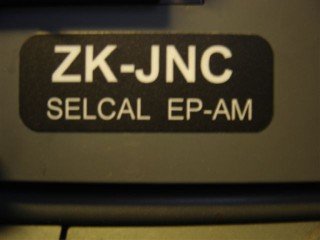SELCAL
One of the disadvantages of High-Frequency Radio, as discussed on the previous page, is the incessant white noise. Listening to this background static for a whole six-hour flight would be distracting and difficult, so Selective Calling (or SELCAL) was devised so that pilots can turn down their noisy radios.
How does it work?
Many aircraft are assigned a four-letter ‘SELCAL code’ enabling them to make use of the system. When a ground operator wishes to communicate with an aircraft, they enter the aircraft's SELCAL code into an encoder which converts each letter into a designated audio tone. The converted tones are broadcast over the radio frequency and are received and interpreted by a decoder on the aircraft's radio receiver, and if the tones match the aircraft's assigned code, then the crew is alerted by a chime, a light, or both. This gives the crew enough time to turn up their radios and receive the transmission from the operator.

Image source: VATSIM New Zealand
Can I choose any code
Not quite. The SELCAL system supports sixteen characters from the Latin alphabet (letters A through S, excluding I, N and O) and the characters are written/transmitted in alphabetical order as two ordered pairs of characters. For example, the code AB-CD is valid, as well as CD-AB, however, BA-CD and DC-BA are not. Each letter in any given code must be unique, so both AA-BC and AC-CD are invalid.
Can I use SELCAL on VATSIM?
SELCAL is simulated on VATSIM by all major pilot clients. Simply enter your SELCAL code and connect! On initial contact with ATC, you can request a ‘SELCAL check’ so that the controller knows that you are SELCAL-capable.
ACA123: Gander Radio, Air Canada 123 request SELCAL check on FS-BQ (Foxrot Sierra Bravo Quebec)
CZQX_FSS: Air Canada 123, Gander Radio, stand by for SELCAL check.
Sources
https://www.skybrary.aero/index.php/Selective_Calling_System_(SELCAL)